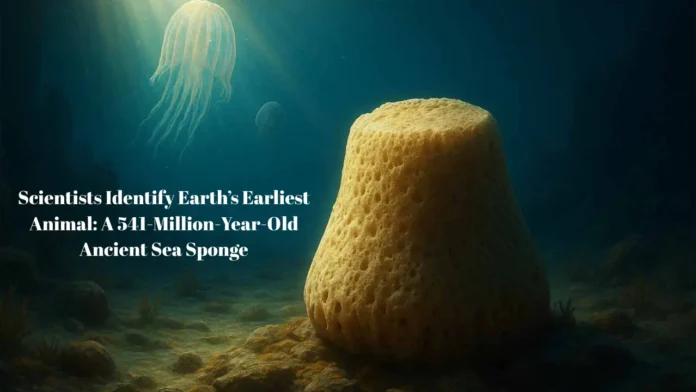For decades, scientists have debated a simple but profound question — what was the first animal to live on Earth? Some believed it was the comb jelly, while others pointed to sponges, primitive but resilient marine creatures that still populate oceans today.
Now, a new study led by MIT researchers appears to have settled that argument once and for all. The evidence suggests that the planet’s earliest animal was an ancient sea sponge, existing around 541 million years ago, long before dinosaurs or even plants took over the land.
Chemical Fossils Reveal the Secret
Instead of relying on traditional fossilized bones or imprints, scientists analyzed “chemical fossils” — molecular traces left behind in ancient rocks. These molecular signatures, found in samples from Oman, western India, and Siberia, hold remnants of life that existed hundreds of millions of years before the Cambrian Explosion.
The team discovered sterols — fatty molecules that form part of cell membranes — preserved in rocks far older than any known animal fossil. Over time, these sterols transformed into steranes, stable compounds that can survive for billions of years.
Their presence indicated something remarkable: the organisms producing them were likely primitive sea sponges, marking them as Earth’s first animals.
The Evidence: A Tale of C30 and C31 Sterols
The breakthrough came when the researchers identified C30 and C31 sterols — rare molecular fossils that have long been linked to ancient sponges.
Back in 2009, a similar study detected C30 steranes in Oman’s rocks, but skeptics argued that non-biological processes could explain the molecules. This time, however, the researchers found high levels of C31 sterols, a compound known to exist only in certain modern demosponge species.
Dr. Roger Summons, one of the lead scientists, explained:
“We still don’t know exactly what these organisms looked like. But they lived in the ocean, had soft bodies, and lacked the silicate skeletons seen in modern sponges.”
The findings, published in the journal Proceedings of the National Academy of Sciences (PNAS), provide the strongest molecular evidence yet that sponges were the first multicellular animals on Earth.
How the Study Was Conducted
The research team extracted and analyzed rock samples from multiple continents. Each sample was carefully tested for sterane molecules using advanced chromatography and mass spectrometry techniques.
They even synthesized eight different types of C31 sterols in the lab to simulate how these molecules might evolve under geological conditions. Astonishingly, only two matched the exact form of those found in the ancient rocks — confirming a biological origin tied to early sea sponges.
Why This Discovery Matters
This discovery isn’t just about identifying an ancient creature. It reshapes the story of evolution itself.
By confirming that sea sponges existed more than 541 million years ago, scientists are effectively pushing back the timeline of animal life by tens of millions of years. It also suggests that the Ediacaran Period, once thought to be dominated by simple microbial life, was home to complex multicellular organisms.
Moreover, this discovery helps scientists understand how early ecosystems functioned and how life managed to survive through catastrophic global changes, including mass extinctions and climate shifts.
A New Chapter in the Story of Life
Lubna Shawar, a co-author of the study, noted that the discovery bridges the gap between biochemistry and paleontology:
“Our work shows how ancient chemical clues can tell us stories that rocks alone cannot. We’re learning that molecular fossils hold the keys to understanding the earliest chapters of Earth’s history.”
The next step for researchers is to search for these sterol signatures in rocks from other parts of the world. If they’re found elsewhere, it could mean that early sponges were more widespread than previously thought — possibly thriving in different oceans across the globe.
From Molecules to Modern Life
Modern sponges might seem simple, but they are biochemically sophisticated. They filter vast quantities of water, support symbiotic microbes, and even produce bioactive compounds that scientists are studying for medical purposes today.
The fact that these humble creatures could be the ancestors of all animals, including humans, adds a poetic touch to the story of evolution. As the researchers put it, the “first animal” was not a predator, not a swimmer — but a silent filter feeder, anchored to the seafloor, paving the way for all life to come.
Conclusion: The Oldest Animal Still Lives Among Us
This groundbreaking research doesn’t just solve an ancient mystery — it also reminds us of the resilience of life.
Despite mass extinctions, shifting continents, and changing climates, sponges have survived for more than half a billion years.
Today, they still inhabit oceans worldwide, quietly continuing the legacy of the first animal on Earth.



